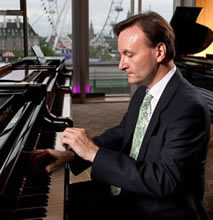Sitting in a space such as the Duke University Chapel, listening to one of the world’s great a cappella singing groups, is a rare treat indeed, and hearing the Tallis Scholars sing music of the Spanish Renaissance, especially two works by Tomás Luis de Victoria, was a first-rate experience that won’t be soon forgotten.
Performing “Dream Visions From the Spanish High Renaissance” before a full house, the ten-member group presented music from about the same time period as the 16th and 17th century Spanish art in the special exhibition at the nearby Nasher Museum of Art. This was polyphonic singing at perhaps its most sublime, requiring and getting the best vocal skills an ensemble can muster.
Victoria (1549-1611) was the best known of the three composers represented in the program, but the works of two contemporaries, Francisco Guerrero (1528-99) and Alonso Lobo (1555-1617), were every bit as musical, technically, emotionally, and spiritually. As the printed program notes, Guerroro was Lobo’s mentor; Victoria likely knew of the two composers but also likely did not meet either.
Guerrero’s “Maria Magdalene,” an Easter seasonal piece, opened the program, and the lovely pure soprano voices hovered over the other parts almost like an angel. The men’s parts (this night’s ensemble consisted of four sopranos, a female alto and a male alto, two tenors, and two basses) condensed into a beautiful knot of sound. As in all works on the program, one was struck by how effortlessly the singers blended voices, even when vocal lines moved at different times.
Lobo’s Missa Maria Magdalene followed, and in this mass, the men’s voices were soft as velvet, so quiet by comparison to the other parts and to other polyphonic choral music with which one might be familiar. Partly because of the acoustics of the setting (the singers stood in a slightly curved line in the front of the chancel area, behind the crossing), the men’s voices did not provide as prominent a foundation as one might normally expect. However, in the “Gloria,” their voices sounded stronger, and the tenors were especially outstanding in the last part of the “Credo.”
The singers did provide splendid dynamic contrasts throughout the program, notably in Lobo’s mass, between the opening of the “Sanctus” and its closing “Hosanna” and between the opening of the “Benedictus” and its closing “Hosanna.” And the “Agnus Dei” was simply gorgeous, with a flowing vocal line, especially in the men’s voices.
Victoria’s “Dum complerentur” and Three Lamentations for Holy Saturday opened the second half of the program and provided some special moments: the men and women trading “alleluias” in the former, for example, and the hushed intonations and tight suspensions of “Heth,” “Teth,” “Aleph,” and “Beth” as introductions to sections of the Lamentations. The men’s voices, by the way, provided great foundation in the “Dum complerentur,” and the Scholars’ controlled straight-tone singing was perhaps best displayed in the Lamentations. The closing of the Lamentations, “Jerusalem, Jerusalem, return to the Lord thy God,” was simply stunning.
Two works by Guerrero brought the program to a close, “Ave Virgo sanctissima” and “Regina caeli.” The former is considered Guerrero’s most famous work, but the latter was perhaps the best selection of the entire concert. The eight-part music, with its fantastic counterpoint, seemed to get more beautiful as it went along, and the ending “alleluias” were gorgeous. These are most certainly not Handel’s “alleluias,” but they were just as inspiring, just as musical, just as meaningful.
The “Ave Virgo” showed well all the skills the Tallis Scholars bring to their material, but this selection also showed the difference between singing in a large cathedral-like setting and singing in a concert hall. Again, perhaps because of the placement of the singers in the vastness of the space, the men’s voices often were nearly swallowed up by the setting, resulting in the loss of ending consonants in several phrases.
This is a minor point, however. Rarely does one attend a choral concert to pay strict attention to a Latin text. One goes to hear the music. And the audience members gathered to hear the Tallis Scholars undoubtedly left this concert thinking that they had heard a great performance of great music. And they did. The Tallis Scholars are a treasure.











